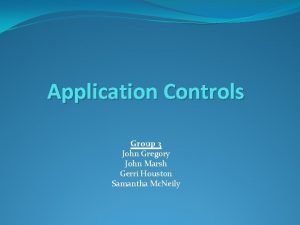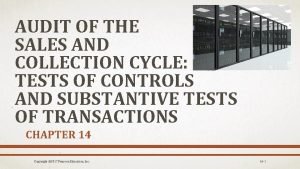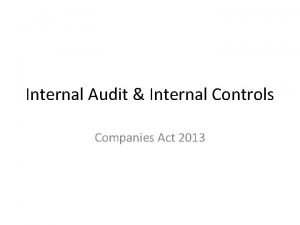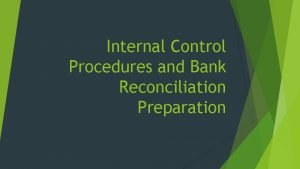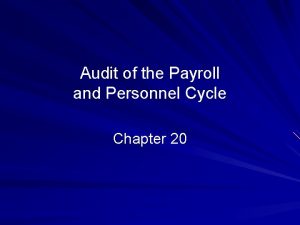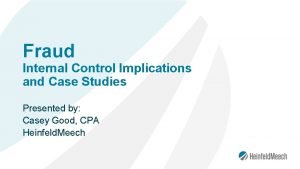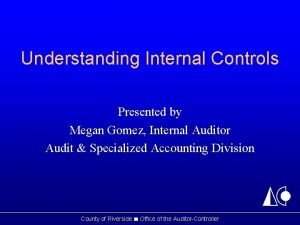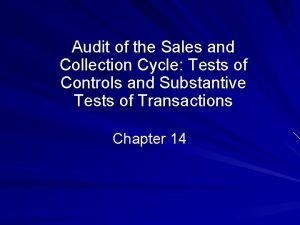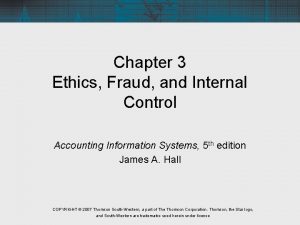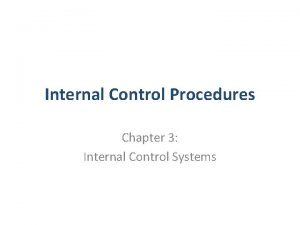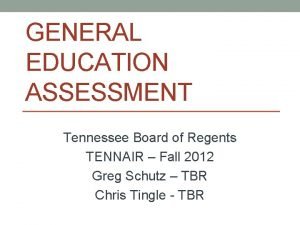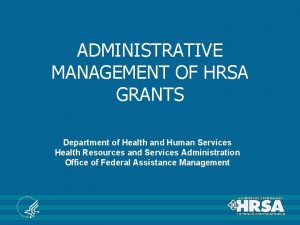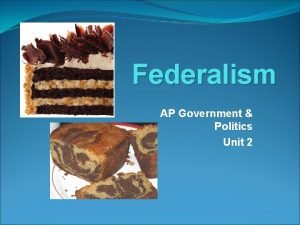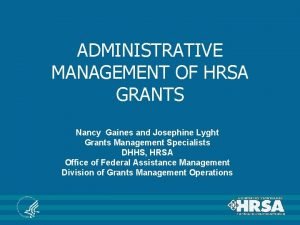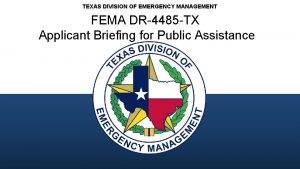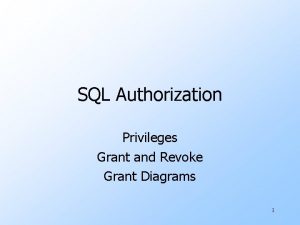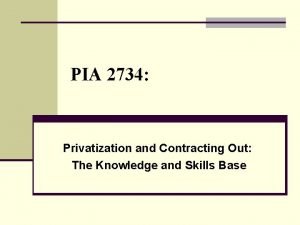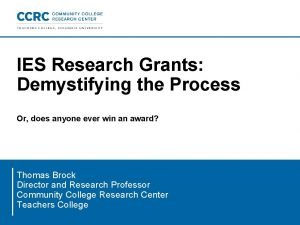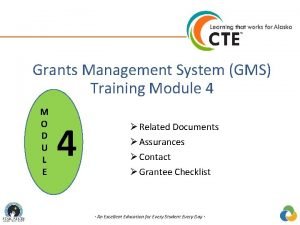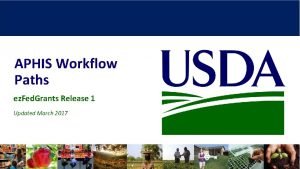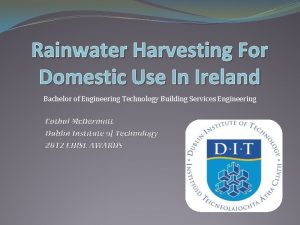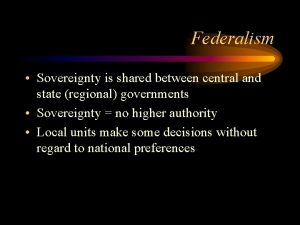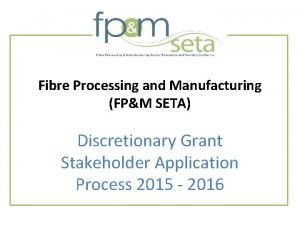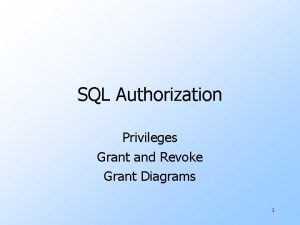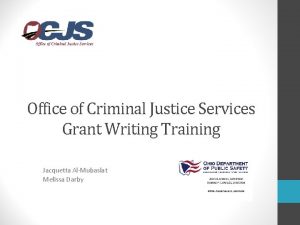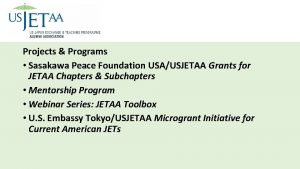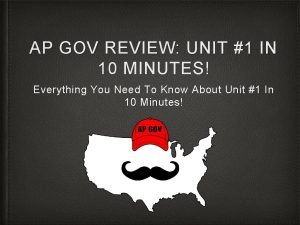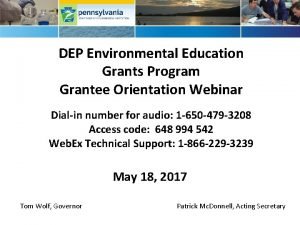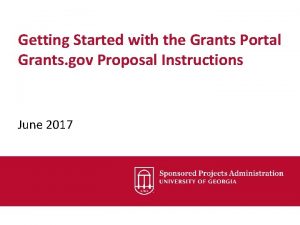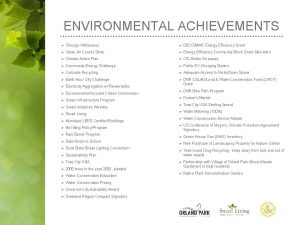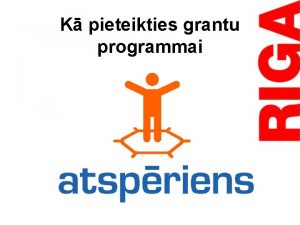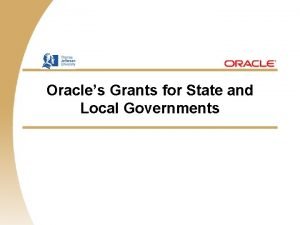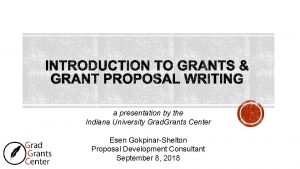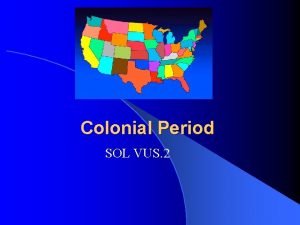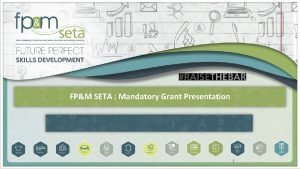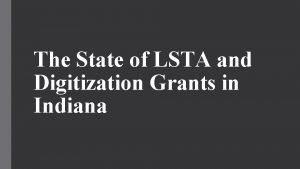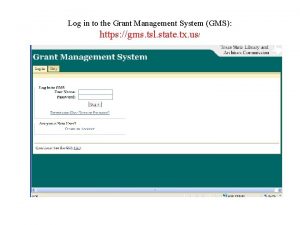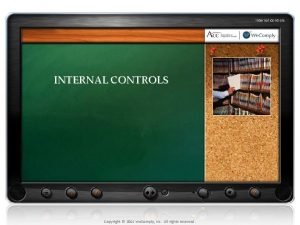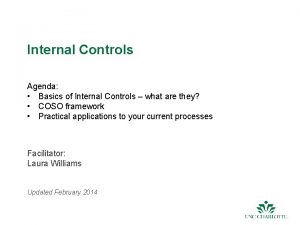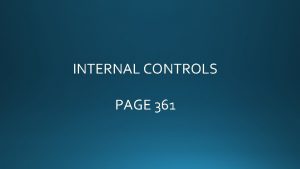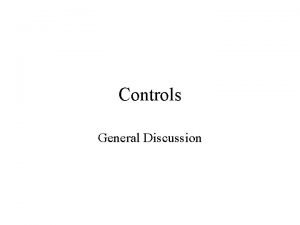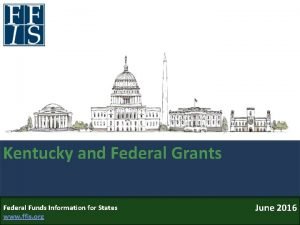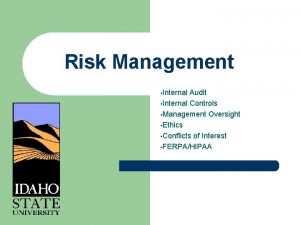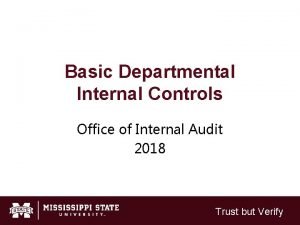Internal Controls for Federal Grants Internal Controls for

















































































- Slides: 81

Internal Controls for Federal Grants

Internal Controls for Federal Grants Steve Weinberger Financial Manager Division of internal Audits Department of Administration dintaud. state. nv. us

Office of Management and Budget Circulars and Codes Federal Grant Guidelines Administrative Requirements Cost Principles Audit Requirements * Universities § 45 CFR 2543 § 2 CFR 215 (formerly A-110) § 2 CFR 220 States, Local, Indian Tribal Governments Non-Profits Hospitals § 45 CFR 2541 OMB A-102 § 45 CFR 2543 § 2 CFR 215 § 2 CFR 225 § 2 CFR 230 § 45 CFR 74 (formerly A-110) (formerly A-21) (formerly A-87) (formerly A-122) (HHS regulations) OMB A-133 Notes: CFR = Code of Federal Regulations * = Organization is subject to A-133 if it expends more than $500, 000 in Federal funds in its fiscal year

OMB A-133 • OMB Circular A-133 (Audits of States and Educational Institutions) v. Entities receiving federal awards must have internal controls designed to provide reasonable assurance that: üTransactions are properly recorded üAssets are safeguarded against loss üReports are complete and accurate üFederal and grant requirements are complied with

Federal Awards • Federal Award (defined) v Federal financial assistance and federal cost-reimbursement contracts that non-federal entities receive directly from federal awarding agencies or indirectly from pass-through entities.

OMB A-133 • OMB Circular A-133 v Audits of States, Local Governments, and Non-Profit Organizations • Compliance Supplement v Compliance requirements to be considered as part the Single Audit Act and OMB Circular A-133 • Part 6 Internal Controls

OMB A-133 Compliance Supplement • Part 6 Internal Control Part 6 is intended to assist non-Federal entities and their auditors in complying with the A-133 compliance requirements.

General Compliance Requirements l Activities Allowed or Unallowed (A) l Allowable Costs/Cost Principles (B) l Cash Management (C) l Davis Bacon Act (D) l Eligibility (E) l Equipment and Real Property Management (F)

General Compliance Requirements (Cont’d) l Matching, Level of Effort, Earmarking (G) l Period of Availability of Federal Funds (H) l Procurement and Suspension and Debarment (I) l Program Income (J) l Real Property Acquisition and Relocation Assistance (K) l Reporting (L) l Subrecipient Monitoring (M)

Internal Controls General notes about Internal Controls: • Provide reasonable assurance that objectives are met • Procedures must be documented v Manuals v Written Procedures • Management is responsible for v Developing v Documenting v Implementing v Monitoring

Activities Allowed & Allowable Costs and Cost Principles (A & B) General • Circular A-87 (relocated to 2 CFR, Part 225*) defines allowable cost principles, • Costs must be: v Necessary v Reasonable v Allocable v Legal under state & local law v Conform with Federal law & grant terms v Consistently treated v Comply with Generally Accepted Accounting Procedures (GAAP) v Not included as match v Net of credits v Adequately documented *Code of Federal Regulations (2 CFR), Subtitle A, Chapter II, part 225

Allowable Costs and Cost Principles (A & B) Necessary & Reasonable • Necessary for the performance or administration of the grant • Reasonable purchase at fair market price v. Necessary – Do we really need it? üWill this be surplus property? üDo we already have existing resources? üIs this the minimum amount I need to spend to meet my need v. Reasonable – Is the expense amount valid? üDid we pay a fair price? Can we prove it? üWould we be comfortable defending this purchase?

Allowable Costs and Cost Principles (A & B) Allocable • Benefits the program somehow • Can only charge in proportion to value received by the program – If a computer is used 50% of the time for a program, you can charge half the cost Legal under state & local law • If it’s illegal you can’t buy it with Federal funds Conform with Federal law & grant terms

Allowable Costs and Cost Principles (A & B) Consistently Treated • Policies apply equally to Federal and non-Federal activities • Cannot assign as direct cost if indirect under state programs Complies with GAAP • Generally Accepted Accounting Principles Not included as a Match • Not part of a match from another program

Allowable Costs and Cost Principles (A & B) Net of Applicable Credits • Purchase discounts, rebates or allowances • Insurance refunds Adequately Documented • • • Amount of funds used for cost How funds are used Share of costs provided by other sources

Allowable Costs and Cost Principles (A & B) 2 CFR, Part 225 provides specific guidance on allowable costs (See handouts) Specifically disallows: v v v Alcoholic beverages Bad debts Donations and contributions Lobbying Selling and marketing Entertainment

Allowable Costs and Cost Principles (A & B) • Direct Costs (Readily identified with program) v Salaries/wages of employees for time devoted to performance of award üKeep payroll records üEstimates time worked on program üSemi-annual certifications if 100% on single program v Materials, supplies used specifically for purpose of the award v Equipment/capital expenditures approved by the specific program v Travel expenses to carry out award

Allowable Costs and Cost Principles (A & B) • Indirect Costs (Not readily identified with program) v Accounting, information technology, human resources, general program management and oversight. üUse SWCAP (Approved by Federal DHHS) üUse an approved Indirect Cost Rate ü Made up of allowable indirect costs

Allowable Costs and Cost Principles (A & B) • Indirect Cost Rate P/B=R v. Indirect Cost Pool (P) v. Direct Cost Base (B) v. Rate (R)

Allowable Costs and Cost Principles (A & B) P: Indirect Cost Pool Salaries Fringe Rent Consultants Travel Supplies Communications Miscellaneous Total Pool $90, 000 30, 000 10, 000 6, 000 5, 000 3, 000 2, 000 4, 000 $150, 000

Allowable Costs and Cost Principles (A & B) B: Direct Cost Base Salaries & Benefits: Trainers Three Counselors Total Direct Sales & Benefits 200, 000 100, 000 300, 000 Other Direct Costs: Occupancy Travel Participant Stipends Participant Support Services Supplies Miscellaneous 90, 000 40, 000 20, 000 30, 000 10, 000 Total Other Direct Total Direct Costs 200, 000 300, 000 200, 000 500, 000

Allowable Costs and Cost Principles (A & B) Indirect Cost Rate (PBR) P: Pool of Indirect Costs B: Base of Direct Costs 150, 000 Salaries & Wages Other Direct Costs Total Direct Cost 300, 000 200, 000 500, 000 R: Indirect Cost Rate 150, 000 500, 000 = 30%

Allowable Costs and Cost Principles (A & B) Allocation Direct Costs Indirect Cost Rate Indirect Costs 100, 000 30% 30, 000 v. Rates must be: üApproved annually by cognizant agency ü Fed agency that contributes most money

Allowable Costs and Cost Principles (A & B) Internal Controls Control Objective • Federal awards are expended only for allowable activities and costs • of goods Services charged to Federal awards are allowable

Allowable Costs and Cost Principles (A & B) Control Procedures l l l l Costs for federal and non-Federal activities are separately accounted for Supporting documentation is maintained for all expenditures Direct charges are for allowable costs Charges used for Indirect Cost Rates are for allowable costs Indirect Cost Rates are approved Supervisor periodically reviews expenditures and computations (document the review) Review should be done by someone other than person authorizing expenditures

Allowable Costs and Cost Principles (A & B) Control Procedures (Cont’d) l Exceptions are corrected and addressed to ensure they don’t happen l l again Management reviews budget to actual reports ( or other performance reports) timely Grant agreements should be available to all personnel preparing reviewing and authorizing expenditures.

Cash Management © General Cash Management Improvement Act of 1990 • Ensure greater efficiency, effectiveness, and equity in states. exchange of funds between Federal government and • State of Nevada has a Treasury-State Agreement (TSA) with the Federal government. v States reimburse interest to Federal government

Cash Management © Internal Controls Control Objective Draw down of Federal for immediate needs only, comply w/TSA and limit payments to subrecipients to immediate needs

Cash Management © Control Procedures • Limit amount of time between drawing and expending funds v Disburse funds received before requesting new funds v Disburse program income, refunds, rebates before requesting new funds v Limit cash advances to subrecipients • Send Incoming Funds Notification to Treasurer’s Office v If ARRA, state on Notification • Forecast cash requirements for each program

Cash Management © Control Activities (Cont’d) • Compare forecast to actual expenditures, investigate variances • • • v Done by someone other than person authorized to do expenditures Draw downs based on actual cash outlays Track draw downs against award amount Try to segregate: v Forecasting cash requirement v Preparing request for draw down v Reviewing the request for draw down

Davis – Bacon Act (D) General Must pay prevailing wages on public works projects • Federally paid or assisted • Rates can be found at: § http: //www. access. gpo. gov//davisbacon/ § http: //www. laborcommissioner. com/

Davis – Bacon Act (D) NRS 338. 1382 • Public work contract requires prevailing wage • Public work – New construction, repair or reconstruction of v Public buildings v Jails and prisons v Public roads v Public highways v Public streets and alleys v Public utilities v Publicly owned water mains and sewers v Public parks and playgrounds v Public convention facilities v All other publicly owned works and properties

Davis – Bacon Act (D) Internal Controls Control Objective • • • Contractors and subs are notified of DB Act requirements Certified payrolls are submitted to state agency Prevailing wages paid Control Activities • Inform contractors of prevailing wage requirements • Compare wages paid by contractors and sub-contractors to prevailing wage v Obtain contractors and subcontractors payroll reports • Management periodically verifies that above 2 procedures being done

Eligibility (E) General • Determining who is eligible to receive Federal funding, and how much they are eligible for Internal Controls Control Objective • Only eligible individuals and organizations receive assistance • Subrecipients are eligible • Amounts provided to or on behalf of eligible parties are properly calculated

Eligibility (E) Control Activities • • • Conflict of Interest statements maintained for people determining eligibility Policies which provide direction for eligibility determinations are documented. Procedures to calculate eligibility requirements consistent with program requirements Use a checklist or automated process when determining eligibility Eligibility determinations should be reviewed and approved by a supervisor before assistance payments begin Verification of information obtained from client verified with an independent third party if possible

Eligibility (E) Control Activities (Cont’d) • Segregate preparing application or eligibility intake form from: v Verifying information on the form v Approving the form v If outside party determines eligibility, ensure they are complying • with program. Management or Independent personnel periodically review: v Eligibility determination process and formulas are consistent w/program v Data used to determine eligibility is accurate and complete • Periodically review clients to determine continued eligibility

Equipment and Real Property Management (F) Internal Controls Control Objective • Ensure proper records are maintained for equipment acquired with • • • Federal awards, Equipment is adequately safeguarded, Disposition or encumbrance of any equipment or real property complies with Federal requirements and Federal awarding agency is appropriately compensated for its share of any property sold

Equipment and Real Property Management (F) Control Procedures • Equipment (Over 5 K) v Must be used in the program for which it was acquired v Records maintained that identify ü Description of equipment ü Serial number ü Acquisition date and cost v Property tags on equipment v Annual physical inventory and reconciliation to records v Management review of inventory and reconciliation v Adequately maintained and safeguarded v Sale of equipment must include competition to extent possible

Equipment and Real Property Management (F) Control Procedures • Real Property v Records maintained that identify ü Title holder ü Acquisition date and cost ü % of Federal participation of the cost ü Location, condition, and disposition data v Used for originally authorized purpose v Approval may be obtained to use for other Federal projects or programs v Consent of awarding agency required to dispose or encumber the title to property v Sale of property must include competition to extent possible v Federal awarding agency gets their share of sales proceeds

Matching, Level of Effort, Earmarking (G) General Matching • Provide contributions of a specified amount or percentage to match • • Federal awards Requirements are unique to each Federal program Found in grant agreement, contract, laws and regulations

Matching, Level of Effort, Earmarking (G) Acceptable Matching Costs • • Verifiable from agency’s records Not included in matching for any other Federal programs Allowable under applicable costs principles Necessary and reasonable Not paid by the Federal Government under a different award Provided for in an approved budget Comply with grant or contract agreement In Kind contributions are valued on an acceptable basis and the basis and valuation are documented

Matching, Level of Effort, Earmarking (G) Level of Effort • A specified level of service to be provided for precise period • A specified level of expenditures from non-Federal or Federal sources for specific activities to be maintained for a precise period v Federal funds should supplement and not replace non-Federal funding of services

Matching, Level of Effort, Earmarking (G) Earmarking • Specify the minimum and/or maximum amount or percentage of the program’s funding that must be used for specified activities and/or subrecipients

Matching, Level of Effort, Earmarking (G) Internal Controls Control Objective • Assure that matching, level of effort, or earmarking requirements are met using only allowable funds or costs which are properly calculated

Matching, Level of Effort, Earmarking (G) Control Procedures • Matching or level of effort requirements are included in the agency’s • • budget Matching, level of effort and earmarking data is tracked separately from other fiscal data Evidence is maintained showing whether contributions: v Are from non-Federal sources v Involve Federal funding, directly or indirectly v Were used for another Federal program

Matching, Level of Effort, Earmarking (G) Control Procedures (Cont’d) • Document the value of in-kind contributions including v Local labor market rates for volunteering v Payroll records from other organizations for their employees v Quotes, published prices or independent appraisals for equipment, land, etc. • Supervisory review of sources used for matching or level of effort • Supervisory review of budget vs. actual

Period of Availability (H) Internal Controls Control Objective • Ensure that Federal funds are used only during the authorized period of availability

Period of Availability (H) Control Procedures • Staff and management should be aware of grant cut-off dates • The accounting system should prevent obligation or expenditure of • • • Federal funds outside of the availability period. Supervisors should review expenditures before and after the cut-off date to ensure compliance with availability requirements Unliquidated commitments should be cancelled at the end of the period Supervisory review of budget vs. actual

Procurement, Suspension and Debarment (I) General • Codes of Conduct v Conflicts of Interest üCannot participate in selection, award or administration of contract if employee, immediate family member, partner has a financial interest in the firm selected for award

Procurement, Suspension and Debarment (I) • Competition v Procurement transaction must not restrict competition such as üUnreasonable requirements in order to qualify üUnnecessary experience or excessive bonding üNon-competitive pricing practices between firms or affiliated companies üSpecifying a brand name instead of allowing an equal product

Procurement, Suspension and Debarment (I) • Solicitations for goods and services provide: v Description of the technical requirements for the material product or service to be procured. Description cannot contain features which unduly restrict competition. v Requirements which the bidder/offeror must fulfill v Description of functions to be performed v Specific Features of “brand name or equal” descriptions that bidders are required to meet. v Preference for products and services that conserve natural resources and protect the environment. (To the extent economically feasible)

Procurement, Suspension and Debarment (I) • Contract cost and price v. Cost Analysis used for sole source, based on offeror’s cost to determine reasonable amount v. Price analysis done for multi-bid, based on comparison of price quotations submitted, market prices, etc v. Cost plus a percentage of cost and percentage of construction cost methods are prohibited.

Procurement, Suspension and Debarment (I) • Procurement Records v. Basis for contractor selection v. If sole source, explain why v. Basis for award cost or price • Contract Administration v. Monitor contractor to ensure compliance with contract terms, specs, etc. v. Document monitoring procedures and results

Procurement, Suspension and Debarment (I) Suspension and Debarment • No awards to any parties that are debarred or suspended • • form participation in Federal assistance programs or activities If >25 k, verify with Excluded Parties List System (EPLS) EPLS maintained by General Services Administration Only award to responsible contractors Consider integrity or past performance issues

Procurement, Suspension and Debarment (I) Internal Controls Control Objective • Ensure that procurement of goods and services comply with federal guidelines and transactions are not made with a debarred or suspended party

Procurement, Suspension and Debarment (I) Control Procedures • Conflict of Interest statements maintained for people responsible for • • • procurement of goods and services Supervisor approval for high dollar, lengthy, or sensitive procurement contracts Solicitations written correctly Follow same procedures as for contracts procured with state $$$ v Contract Manager v Contract Monitor v Segregate approving contract, monitoring contract, and paying contract

Procurement, Suspension and Debarment (I) Control Procedures (Cont’d) • Document contract monitor procedures v Verify performance with terms, conditions and specs of contract v Quality of goods, warranties, and delivery schedules • Written Policy prohibiting business with suspended or debarred parties v If equal or greater than 25 K, specify how you determined above v Excluded Parties Listing System – maintained by General Services Administration

Procurement, Suspension and Debarment (I) Control Procedures (Cont’d) • Perform a cost or price analysis • Maintain records for: v Basis for contractor selection v Justification of sole source v Basis of award cost or price

Procurement, Suspension and Debarment (I) Control Procedures (Cont’d) • Management reviews for: v Conflicts of interest, bribes, kickbacks, etc v Restrictions on competition v Using small businesses and firms owned by women and minorities v Sole source justification

Program Income (J) General • Program Income earned as v. Fees for services performed v. Rental of property acquired with grant funds v. Sale of commodities or items fabricated under a grant v. Payments of principal and interest on loans made with grant funds

Program Income (J) • Program income must be v. Deducted from outlays v. Added to the project budget v. Used for matching requirements • Use of income may be specified in award • If not specified, must be deducted from outlays

Program Income (J) Internal Controls Control Objective • Ensure program income is correctly earned, recorded and used in accordance with program requirements

Program Income (J) Control Procedures • • • Income collection procedures are same as those for state funded Deposit procedures same as state funded Program income is properly identified (not commingled with state income) Supervisory review done to ensure program income used properly Management compares budget to actual and investigates variances

Real Property Acquisition and Relocation Assistance (K) General • Comply with Uniform Relocation Assistance and Real Property Acquisition Policies Act of 1970 (URA)

Real Property Acquisition and Relocation Assistance (K) URA • Real Property Acquisition v. Appraise before negotiation v. Invite property owner to appraisal v. Provide property owner with written offer of just compensation summary v. Pay for property before possession v. Reimburse property owner for recording fees, prepaid real estate taxes, or other such expenses

Real Property Acquisition and Relocation Assistance (K) • Residential Replacement v Provide relocation advisory services v Minimum 90 days written notice to vacate v Reimburse moving expenses v Pay for added costs of renting or purchasing comparable replacement property • Non-residential Replacement v Provide relocation advisory services v 90 days notice v Reimburse for moving and reestablishment expenses

Real Property Acquisition and Relocation Assistance (K) Internal Controls Control Objective • Ensure compliance with real property acquisition, appraisal, negotiation and relocation requirements

Real Property Acquisition and Relocation Assistance (K) Control Procedures • Maintain written policies of relocation assistance and real property • • acquisition that comply with Federal regulation Have copies of regulations available for personnel administering programs Use a checklist to ensure compliance with URA Send pamphlets to persons being relocated informing them of their rights and the prescribed procedures Request written acknowledgement of persons being relocated and that their rights and prescribed procedures have been made available to them

Real Property Acquisition and Relocation Assistance (K) Control Procedures (Cont’d) • Be aware of homeowners trying to take advantage of relocation assistance v Financial means for house being acquired • Assign a supervisor to monitor for v Compliance with URA v Appraisals are reasonable compared with prior appraisals • Price and negotiation settlements are reviewed by an appropriately • designated official Records are maintained for all acquisitions and displacements

Reporting (L) General Three types of reports • Monitoring and Performance v Compare actual accomplishments to goals or objectives • Financial v Provide financial status of funds • Special Reporting

Reporting (L) Internal Controls Control Objective • Ensure Federal reports are submitted timely, include all activity in the reporting period, are supported by appropriate records and are fairly presented in accordance with program requirements

Reporting (L) Control Procedures • • Have a tracking system which reminds staff when reports are due Use general ledger or other reliable records as basis of reports Written procedures showing how to prepare reports and sources to use Use reconciliations when possible

Reporting (L) Control Procedures (Cont’d) • Supervisory review of reports for v Accuracy v Completeness of data v Proper information contained in report v Correct accounting method used (cash or accrual)

Subrecipient Monitoring (M) General Subrecipient vs. Vendor (See Handout) • Subrecipient v Determines eligibility v Uses performance measures v Programmatic decision making v Comply with program requirements v Carries out the program (as opposed to providing services)

Subrecipient Monitoring (M) Subrecipient vs. Vendor (Cont’d) • Vendor v Provides goods and services normal business activities v Provides similar goods to different entities v Operates in a competitive environment v Provides goods or services that are ancillary to program v Not subject to compliance requirements

Subrecipient Monitoring (M) Internal Controls Control Objective • Federal award information and compliance requirements are • • • identified to subrecipients Subrecipient activities are monitored Subrecipient audit findings are resolved Ensure Subrecipient obtains required audits

Subrecipient Monitoring (M) Control Procedures • Maintain a current list of all subrecipients • Award document should contain: v Description and program number as stated in CFDA v A listing of Federal requirements. Items can be in award or attachment v A statement signed by an official of the subrecipient acknowledging that the subrecipient was of informed of, understands, and agrees to comply with the applicable requirements

Subrecipient Monitoring (M) Control Procedures (Cont’d) • Monitoring v Perform on-site visits to review financial and program records and observe operations. Document procedures performed v Document and follow-up on any deficiencies noted v Review subrecipient reports and follow-up on any concerns v Monitor subrecipient budgets v Use time tracking to ensure timely monitoring, report submission and follow-up of noted deficiencies

Subrecipient Monitoring (M) Control Procedures (Cont’d) • Monitoring (cont’d) v Follow-up on prior audit or on-site review findings v Consider risk factors such as: ü Size of grant ü Size of subrecipient ü Economic and political conditions, regulatory changes ü Subrecipient financial problems, loss of personnel, new activities v Monitors should be objective and independent of subrecipient v Supervisors should review monitoring work papers and procedures to ensure they are timely and complete

Subrecipient Monitoring (M) Control Procedures (Cont’d) • Single Audit v Determine by inquiry if subrecipient should be audited v If required, ensure that subrecipient submits required reports v If subrecipient fails to submit reports, withhold further funding

Internal Controls for Grants That’s It - Finally Thank You
 Federal block grants
Federal block grants General controls vs application controls
General controls vs application controls He who controls the past controls the future
He who controls the past controls the future Internal controls for sales and collection cycle
Internal controls for sales and collection cycle Explain the concept of internal control
Explain the concept of internal control Cavr audit assertions
Cavr audit assertions Audit program for revenue cycle
Audit program for revenue cycle Internal financial controls
Internal financial controls Fraud internal control and cash
Fraud internal control and cash Bank reconciliation fraud
Bank reconciliation fraud Payroll cycle audit
Payroll cycle audit Internal control case study
Internal control case study Internal controls
Internal controls Sales and collection cycle
Sales and collection cycle Chapter 3 ethics fraud and internal control
Chapter 3 ethics fraud and internal control 5 internal controls accounting
5 internal controls accounting Grants ap gov
Grants ap gov Uncc.instructure
Uncc.instructure Tennair
Tennair Discretionary grants definition
Discretionary grants definition Noaa acquisition and grants office
Noaa acquisition and grants office Hrsa capital grants
Hrsa capital grants Grants ap gov
Grants ap gov Hrsa grants management
Hrsa grants management Tdem grants management system
Tdem grants management system Finnish cultural foundation
Finnish cultural foundation Privilege diagram
Privilege diagram Categorial grants
Categorial grants Ies research grants
Ies research grants Grants management system gms
Grants management system gms Ezfedgrants
Ezfedgrants New jersey grants & scholarships 2020-21
New jersey grants & scholarships 2020-21 Emd
Emd Rainwater harvesting system ireland
Rainwater harvesting system ireland Creative federalism definition
Creative federalism definition Fpm seta
Fpm seta Grants lick elementary
Grants lick elementary Ken emond british academy
Ken emond british academy Ezfedgrants external portal
Ezfedgrants external portal Allstate moving ahead curriculum
Allstate moving ahead curriculum Ez fed grants
Ez fed grants Sql authorization mechanism grants privileges on
Sql authorization mechanism grants privileges on Ohio office of criminal justice services
Ohio office of criminal justice services Sasakawa peace foundation grants
Sasakawa peace foundation grants Grants ap gov
Grants ap gov Dep environmental education grants
Dep environmental education grants Grants portal uga
Grants portal uga Nato pdd grants
Nato pdd grants Energy efficiency grants chicago
Energy efficiency grants chicago Dorset growth hub
Dorset growth hub Kas ir granti
Kas ir granti Equity trustees grants
Equity trustees grants Oracle state and local government
Oracle state and local government Ba flexigrant
Ba flexigrant Grants online noaa
Grants online noaa St clair county grants department
St clair county grants department Ad grants creation guide
Ad grants creation guide Ddrig nsf
Ddrig nsf Museum timelinefy
Museum timelinefy Iu grad grants
Iu grad grants English nobility who received large land grants
English nobility who received large land grants Fp&m seta contact details
Fp&m seta contact details How did land grants and new roads affect brazil?
How did land grants and new roads affect brazil? Digitization grants
Digitization grants Pcgo
Pcgo Lions club international foundation grant
Lions club international foundation grant Grants management system gms
Grants management system gms Arts council national lottery project grants
Arts council national lottery project grants Tobinskatten för och nackdelar
Tobinskatten för och nackdelar Nationell inriktning för artificiell intelligens
Nationell inriktning för artificiell intelligens Referatmarkeringar
Referatmarkeringar Karttecken sten
Karttecken sten Vanlig celldelning
Vanlig celldelning Programskede byggprocessen
Programskede byggprocessen Rådet för byggkompetens
Rådet för byggkompetens Tryck formel
Tryck formel Underlag för särskild löneskatt på pensionskostnader
Underlag för särskild löneskatt på pensionskostnader Densitet vatten
Densitet vatten Elektronik för barn
Elektronik för barn Tack för att ni har lyssnat
Tack för att ni har lyssnat Smärtskolan kunskap för livet
Smärtskolan kunskap för livet Jiddisch
Jiddisch

